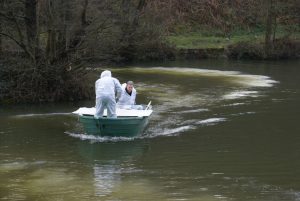Grants for Siltex treatment
In the last month both Ravenfield and Baker’s have been notified that they have received grants for the application of Siltex. In the case of the former, Tesco’s Bags of Help scheme is providing the funds to make two applications, in autumn this year and spring next to the Carp Pond, and similar funding is being provided by the Environment Agency as part of its Fisheries Improvement Fund Programme, to treat Baker’s.
As can be seen from the picture, which shows Dennis and Dave at Baker’s, Siltex is applied from a boat directly to the water body.
So what is it and what does it do?
Siltex is used as an inexpensive way of reducing organic silt and improving water quality in ponds, lakes and waterways. It is environmentally friendly, harmless to plants, fish and all other water inhabitants, and as it recycles the organic materials (silt), it is a great benefit to the water body ecosystem. Siltex will also stimulate the water-body food chain which will help to increase biodiversity.
So what is it?
Siltex is a highly porous form of Calcium Carbonate consisting of microscopic particles with an average size of less than 5 microns (5/1,000 of a millimetre!). Being Calcium Carbonate it is completely harmless to plants and wildlife.
And what are the main benefits?
Siltex decreases organic and oxidisable matter which is displayed as a reduction in silt levels. It increases oxygenation and stimulates aerobic micro-organisms. It improves water clarity by settling suspended waterborne solids.It reduces methane production by the silt body. It counteracts acidity in the water and the silt. It provides essential Calcium for plants and wildlife. Because of all these it increases biodiversity within the water body.
How does it do all these things?
Firstly, we need to understand what silt is. Silt is organic matter, plus sand and clay, combined with water, which forms a spongy mass. Organic silt accumulates when the micro-organisms that normally feed on the organic matter are no longer present, due to low oxygen levels and increased acidity. The microscopic Siltex particles are able to penetrate right in to the silt layer and create the right environment for the micro-organisms to re-establish themselves and start to digest the organic matter, thus reducing the silt volume. It works best when the silt has a high organic content, combined with acidity.
Siltex has been applied before to Baker’s Pond, a once heavily polluted steelworks pond, with surprisingly good results.

